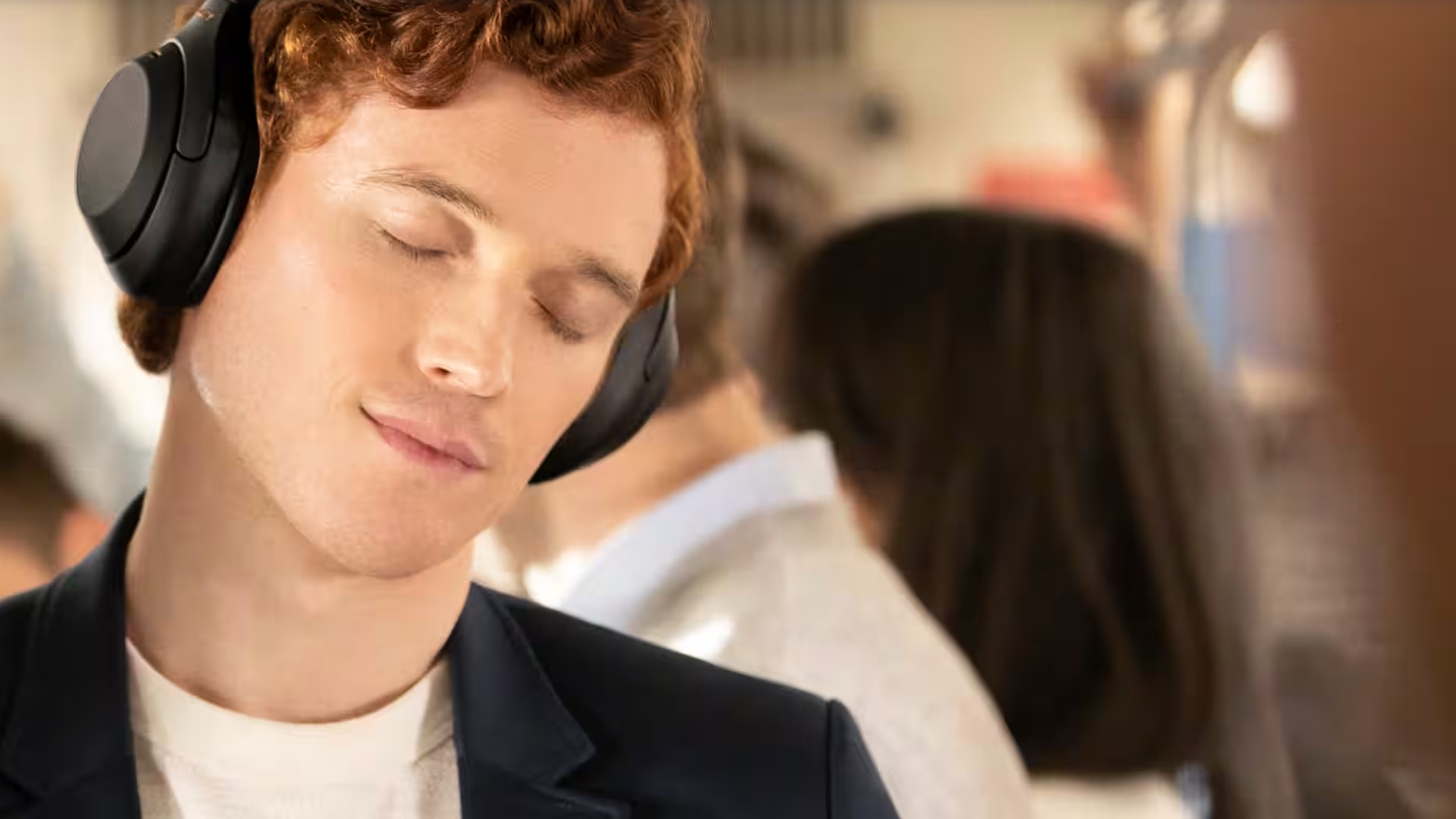
- Noise-cancelling headphones explained
- Active noise cancellation explained
- How ANC headphones work
- How ANC 'blocks out' sound
- ANC-supporting headphones
- Types of ANC
- Adaptive hybrid ANC explained
- Transparency mode explained
- The function of ANC
- Audiophile ANC headphones
- ANC battery life
- ANC hearing damage
You can't have missed the rise of ANC. It's become the must-have audio feature – the consumer space feels duty bound to squirrel noise-cancelling tech into even the best noise-cancelling earbuds. And audio brands do this for good reason: nothing else offers quite the same experience or isolation.
But what exactly is active noise cancelling? How does it work? And what are the best noise-cancelling headphones to buy if you really can't stand to listen to any of the world around you? Let's break it down, from the magic behind the tech, to the kinds of ANC you'll find on the market today – even in budget headphones and earbuds.
What are noise-cancelling headphones?
There's a clue in the name: they're headphones that cut out background noise. Passive noise cancelling – the act of blocking out sound using non-electronic means – has been around since humans discovered they could put their fingers in their ears, and is the technique by which many headphones still cut down on background sound.
Active noise cancelling, however, is far newer. The story, however apocryphal it may be, goes like this: in 1978, Amar Bose, the late founder and chairman of Bose Corporation, was on a transatlantic flight. The airline-supplied headphones on his noggin did such a poor job of blocking off the aircraft's engine noise – and, indeed, annoyed him so much – that he invented active noise cancellation right there and then, sketching out the maths on a tray table napkin. By the time the plane touched down, he was done, and the electronic alternative to ear fingers was in motion.
Noise cancelling took its time coming to market. It was not until 1989 that pilots got their ears on Bose's first commercial take on the tech, and 11 more years until consumers were treated to Bose's QC1 cans, complete with bulky external battery box.
Fast-forward to the present day and ANC is everywhere, even in some of the best budget wireless earbuds, thanks to the public's love of a quiet life leading to a glut of cut-price processors.
How does active noise cancellation work?
We're not entirely sure why Amar Bose took a whole flight to work on the equations, because the concept of ANC is really quite simple.
Get daily insight, inspiration and deals in your inbox
Sign up for breaking news, reviews, opinion, top tech deals, and more.
Imagine an image of an audio waveform, with its peaks and troughs. Now imagine the same waveform, but with its phase reversed – what was a peak becomes a trough, and vice versa. Those waveforms represent changes in air pressure; play them simultaneously and the pressure is (in theory) equalized to a straight line, therefore the phase inverted waveform cancels out the original. Invert noise and you get anti-noise. Combine them, and you get nothing.
OK, admittedly that's a very basic explanation of the theory. The tech behind ANC is far more complex, particularly given that the sounds we hear very rarely conform to a regular, easy-to-cancel waveform. ANC needs to react fast to frequent changes in outside sound – it's a processor-intensive task which challenges even the best earbuds.
How do ANC headphones work?
Though the tech is decades old, ANC headphones and earbuds still use the same techniques developed all those years ago. Microphones on the earpiece listen to the ambient noise around them, then a processor feeds anti-noise – that phase-flipped opposite version of what they're hearing – into the headphones' drivers, mixed with whatever you're playing, to selectively cancel out the unwanted frequencies.
There's a rather obvious flaw in this plan. It takes time for the microphone's signal to be analysed, converted, and sent to your ears. Latency like this can't be avoided, so ANC engines need to make estimates. This is the reason they're better at blocking out consistent background noise than they are at dealing with sudden sounds and also explains why there's such a void between just-OK and exemplary examples of ANC. It's all in the code.
The other minor issue is that ANC's anti-noise can very slightly muddy the signal you actually want to hear. The best ANC headphones stand out through their ability to compensate for this signal loss and maintain a full and rich sound no matter what's happening outside, plus how they avoid filtering the sound that you actually want to hear.

Does ANC completely block out sound?
In short, no – when we say 'blocking out' we're using convenient shorthand for 'significantly reducing'. ANC's anti-phase signal is generated from what its microphones can hear, which is never going to be a perfect analogue for what your ears can hear. The attenuated sound then needs to be lined up, as perfectly as possible, with the actual sound of the real world – a task which even the most microscopic amount of lag throws out of whack.
There are going to be sounds that slip through even the best ANC headsets, but you'll generally see a reduction of background noise by between 20-40dB. In the latter case, that means you'll hear about one-sixteenth of the background noise.
Better headphones will do a better job of selective ANC. In cheaper models, you might find the eventual soundstage is flattened, particularly if the ANC engine starts trying to cancel out any leaking artefacts of your music.
What kind of headphones support ANC?
ANC headphones and earbuds are almost always closed-back, meaning they also feature a high amount of passive noise cancelling through such features as silicone or memory foam ear tips or cups. This isn't just to compensate for the things ANC can't do (though it doesn't hurt) but also because the nature of ANC means just doesn't work well with open-back headphones.
Open-back cans like the Sennheiser HD-660S2 are designed to let the outside in. They're made for leaning back in a quiet environment and letting your music do the work. And as anyone who's sat next to an open-back user on the bus will know, they leak about as much audio as they direct to the ear.
ANC thrives in a closed environment where it can affect only a tiny amount of air. It would be absolutely overwhelmed if used with open-back headphones, and almost certainly encounter incredible levels of feedback.
What types of ANC are out there?
Not all noise cancellation is made equal. There are three key kinds of ANC on the market:
Feedforward ANC
Feedforward is the most basic ANC setup. A microphone (or an array of them) is placed on the outside of the earphone which picks up the sound. Then, a processor feeds the inverted ambient noise signal forward into the ear. Feedforward devices are a little finicky about how you wear the headset – a small open area can create high-frequency feedback, and wind noise tends to trouble the microphones. Given its unpredictable nature, wind can be especially difficult to filter out.
Feedback ANC
This moves the ANC microphone and places it directly inside the ear cup instead. That makes feedback ANC more adept at reacting to what you're actually hearing, no matter how you're wearing the headphones, and significantly reduces that wind noise problem. On the other hand, feedback ANC devices tend to struggle with high-frequency noise, and need stronger processors to work out how to separate background sounds from the audio you're actually trying to listen to.
Hybrid ANC
A hybrid design is a bit of both. It's a mix of feedforward and feedback ANC which can handle a wider range of frequencies, dealing with what's outside but also what's leaking in. Hybrid devices are usually a fair amount more expensive, both because of the extra mics and the additional processing required to analyse and adapt to the twin audio sources, but they're even more forgiving in terms of the way you're able to wear your headphones, and produce a stronger overall effect.
In truth, the majority of modern headphones use a hybrid design, which is handy – knowing about the different kinds of ANC would be much more useful if manufacturers were ever clear about exactly what their headphones sported. And, guess what, kids – they're not.
Just know that you'll get a decent ANC experience top to bottom. Even budget buds like the Sony WF-C700N, the Nothing Ear (a) and EarFun Air Pro 3 can manage a decent effect. (Which is best out of those first two? See our Nothing Ear (a) versus Sony WF-C700N deep dive).
What is adaptive hybrid ANC?
Ah, OK, you got us – maybe there's a fourth kind of ANC, depending on how you see the world. Adaptive hybrid ANC is hybrid ANC that lathers on a stack of extra processing to consistently compensate for sudden changes, adding extra ANC when things are noisy and dialing down the effect when you're in quieter surroundings.
Adaptive ANC often also adds extra smarts to listen for both noise leakage and unwanted reverberations within your ear canals. In terms of strength, it's the vodka to normal hybrid's red wine. Basic feedforward is a light beer.
You'll see manufacturers advertising their own special ANC varieties, but they'll typically just be a branding exercise. Do your research, and don't be fooled. Every device's ANC abilities are slightly different based on the positioning of their mics, the processing involved, and even the passive noise cancelling from their ear tips or cups.
We'd have to tip our hat to Apple when it comes to truly stunning adaptive ANC: the AirPods Pro 2 really defined what was possible in the space, and they still sound amazing against today's competition. Don't discount Bose's QuietComfort Ultra Earbuds, though – that's some class-leading ANC.
How does transparency mode work?
It works exactly as you'd imagine: just like noise cancelling, but in reverse.
With a transparency or pass-through mode switched on, your headphones take audio from the feedforward mics on the outside and, rather than processing out the noise, they amplify it and mix it in with whatever audio you have playing.
As ANC processors have improved over the years, transparency modes have really highlighted their enhanced abilities. The earliest attempts tended to sound harshly robotic or, if they didn't, they'd introduce noticeable lag. Today, they can selectively filter in the frequencies you actually want to hear.
In fact, ANC transparency modes are so powerful that some manufacturers are using them to move into the over-the-counter hearing aid space. JLab's Hear OTC ($100/about £75/about AU$150) is the most notable example so far, but more are surely coming.
Note that transparency mode is usually rather slow to switch on – though certain headphones, like Bose's QuietComfort 45, have a function called Aware Assist, which lets you briefly fire it up when there's something you want to hear, then relax back into isolated bliss when you're done.
Is ANC just for making headphones sound better?
Yes and no.
Yes, in the sense that you'll usually only find it in headphones and earbuds. We suppose you could (with a suitably tuned and powerful speaker and a bunch of scientific know-how) cancel out real-world frequencies if you were so inclined. But most people don't, funnily enough.
No, in the sense that ANC pulls double duty on most headphones, looking after not only the audio that reaches your ears but also the audio that leaves your mouth, chopping out unwanted noise in calls and voice recordings. This is possible both because most headphones use multiple microphones – often two or three per ear for ANC, which can be selectively used to pick up voice frequencies – and because the process of cleaning up the input from your call mic is essentially no different from regular noise cancelling or transparency duties.

Do audiophile headphones have ANC?
Some very high-end headphones feature an option of using ANC – we'd direct you to the tremendous Focal Bathys cans, for example – but if you're using 'audiophile' in its strictest sense, the answer is no. For the absolute best listening experience you'll need completely unadulterated sound.
ANC is, by its very definition, an adulteration. The sound that reaches your ears has been fundamentally altered and mixed with some wild frequencies that, if roles were reversed and the background noise were not there to cancel them out, would sound awful.
You'll also need a wired connection (see our roundup of the best wired headphones for some excellent options) for the best sound, because most wireless codecs apply some kind of lossy compression to audio. ANC headphones are generally wireless, as the processing tech relies on battery power.
But don't let any of this put you off. It's not one or the other – ANC still sounds amazing, and you can have both. Super high-end headphones at home, ANC devices everywhere else.
Why does ANC reduce battery life?
It's a question of energy.
With passive noise cancelling, your headphones don't need to impart any energy to block out sound – the foam or silicone absorbs it. Switch off your ANC, and your headphones' materials are doing all the work. The only battery drained will be from the wireless headphones' Bluetooth radio, any processing needed to resolve wireless codecs, and that needed to create the sound itself.
With ANC switched on, you're also switching on a tiny processor, or perhaps one in each ear, which must use extra energy to generate the noise-cancelling signal. Typically this will cut between two and five hours off the battery life, but given that headphones like the perennially excellent Sony WH-1000XM4 can manage a huge 30 hours on a charge, the effect of ANC is relatively negligible.
Will ANC damage my hearing?
ANC won't damage your hearing or cause any hearing loss. If anything, it's a positive – having that background noise chopped out means you won't have to drive your tunes quite so hard for them to be heard.
That said, not everyone gets on well with the feeling of using ANC. For some, the silence serves to highlight their tinnitus. For others, the extra pressure inside the ear from the anti-noise signal can leave them feeling a little wobbly.
Perhaps the biggest danger posed by ANC is the isolation, and the fact that you'll be less able to hear any hazards around you when out and about. Consider a set of ANC headphones with adjustable noise cancelling levels if you're likely to be using them while out and about. The majority of Bose's range for example, lets you set your level, meaning you might just notice that near-silent EV before it's too late. Try the older but still very good Bose Noise Cancelling Headphones 700, or the QuietComfort 45s.
You may also like
- Don't want to empty your wallet for good ANC? Here's our guide to the best budget wireless earbuds
- Need more options for in-ear silence? Here's our pick of the best noise-cancelling earbuds
- Want the best sound possible? Not concerned about ANC? Check out the best wired headphones
- See our roundup of the best earbuds you can buy right now